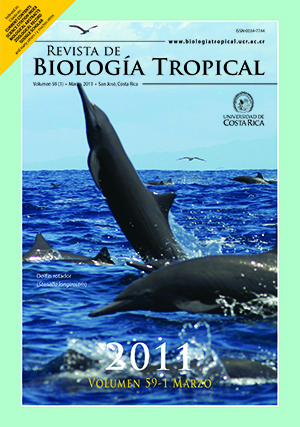Resumen
Thalassia testudinum es la macrófita dominante en Bahía de la Ascensión (Quintana Roo, México), se estudió para conocer su distribución espacio-temporal y determinar si fue afectada por el paso de huracanes que se han visto incrementados en fuerza y frecuencia por el cambio climático. Partiendo de una imagen Landsat ETM+ de 2001 y usando información de grandes grupos morfofuncionales y de cobertura de T. testudinum adquiridas en 525 estaciones de muestreo, se obtienen las semillas para la clasificación supervisada de los hábitats bénticos (8 clases). Con el fin de cuantificar los cambios ocasionados por dos huracanes, se usaron dos imágenes, una de 1988 (Gilberto) y 1995 (Roxanne) y tres más (2003, 2005 y 2007) para monitoreo sin efectos meteorológicos mayores; a estos 6 mapas categóricos se les aplicó un análisis de Ecología del Paisaje usando 8 índices que describen las características espaciales, de estructura, función, cambio de los elementos (matriz-mancha-corredor), efectos sobre el ecosistema, conectividad, bordes, forma del parche y fragmentación del hábitat. Los modelos indican que T. testudinum puede clasificarse como un continuo (matriz), pues los fragmentos no se observan de forma intermitente, sino como una progresión de zonas mínimas a máximas en referencia a su cobertura (corredores ecológicos). No poseen una forma regular, indicando que los impactos son recientes y pueden ser debidos a efectos directos (huracanes de alta intensidad) e indirectos (aporte de sedimentos). Los fragmentos de tipo "suelos desnudos" presentan una distribución discontinua, considerándose sitios que han permanecido estables en una larga escala de tiempo; las zonas con coberturas más densas ("camas", "praderas medias" y "praderas") presentan baja fragmentación y alta conexión de sus fragmentos. Las características de poseer un perímetro irregular y crecimiento de formal radial, sugieren que el impacto de los meteoros no tiene efecto en la capacidad de resiliencia de T. testudinum en este ecosistema, indicando el buen estado de la calidad ambiental de la bahía para su crecimiento.
Esta obra está bajo una licencia internacional Creative Commons Atribución 4.0.
Derechos de autor 2011 Revista de Biología Tropical
Descargas
Los datos de descargas todavía no están disponibles.

